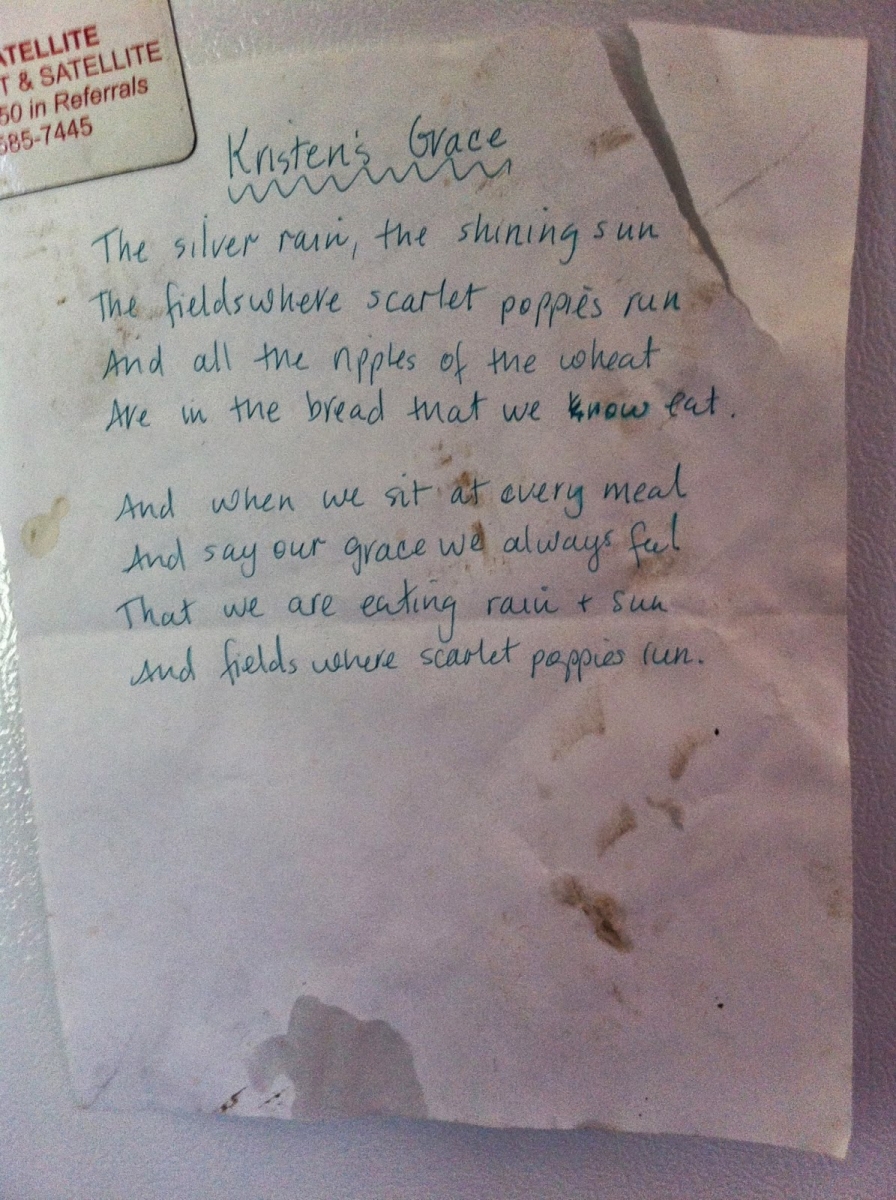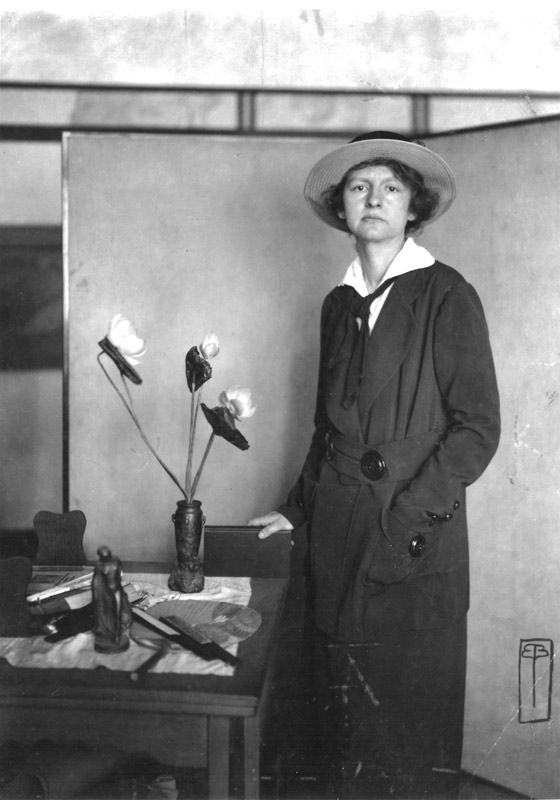
One of my favorite parts of Willamette University is Zena Farm—a five-acre, student-operated farm that is part of a larger, 305-acre property that includes a forest and a small observatory in Oregon’s Eola Hills just about ten miles west of campus and Salem proper. Overseen and managed by W.U.’s Sustainability Institute, the farm is a laboratory for all sorts of cool interdisciplinary, place-based learning experiences. It sells produce at a campus farm stand during the school year. And it’s the site of the Summer Institute in Sustainable Agriculture—a residential, credit-granting program that mixes hands-on learning with field trips, independent projects, and academic study in the theories and philosophies of sustainable agriculture.

Out at the farm having lunch with students and the program leader one afternoon this summer, I happened to notice a handwritten poem (pictured here) tacked to the side of the refrigerator. It’s called “Kristen’s Grace” and reads:
The silver rain, the shining sun
The fields where scarlet poppies run
And all the ripples of the wheat
Are in the bread that we now eat.
And when we sit at every meal
And say our grace we always feel
That we are eating rain and sun
And fields where scarlet poppies run.
For me, the “scarlet poppies” of “Kristen’s Grace” immediately called to mind the poppies of John McCrae’s famous World War I poem “In Flanders Fields” (about which I blogged a year ago), and so, intrigued by the apparent distance between World War I and what’s generally going on at Zena, I decided to do a little poking around. Who was Kristen, and was this her poem or her grace—or both? Might the poppies really link back to McCrae, World War I, and the buddy poppy, or was I just reading like an English major reads? And, if the poem’s poppies did link back to McCrae, how would that affect how to read “Kristen’s Grace” today, especially in relation to the farm’s mission?
I quickly discovered that Kristen was a student who worked on the farm one summer and that, while this was and perhaps still is her grace, she wasn’t the author of the poem. In fact, as my casual online searches revealed, it’s a verse not uncommonly cited and used by sustainable foodie types—and sometimes by feminist types who see in the scarlet poppies a figure for menstruation—and it’s usually titled “The Harvest” and attributed to Alice Corbin Henderson.

So who, you might be wondering, is Alice Corbin Henderson? Well, if it’s the Alice Corbin Henderson I expect she is, then “Winter Harvest” not only links us to McCrae’s poppies and Remembrance Day but also to Poetry magazine, where Henderson (1881-1949) was an editor and close associate of Harriet Monroe in the magazine’s early years, co-editing with Monroe three editions (1917, 1923, 1932) of The New Poetry anthology. Henderson (pictured here) graduated from high school in Chicago and entered the University of Chicago, but due to her susceptibility to tuberculosis, she relocated to Sophie Newcomb College in New Orleans for the remainder of undergraduate school. (Henderson’s mother died of tuberculosis when Alice was three.) Upon graduation, Alice moved back to the Windy City where she took classes at Chicago’s Academy of Fine Arts, in the process meeting and eventually marrying William Penhallow Henderson, an Academy instructor and notable Arts and Crafts artist who, among other things, was working on Frank Lloyd Wright’s Midway Gardens Project. Alice worked with Poetry and she also wrote poetry; her first book Linnet Songs was published in 1898 when she was seventeen years old.
Because of Alice’s persistent health concerns, the Hendersons relocated to the more pulmonary-friendly climes of New Mexico, settling in Santa Fe and becoming central figures in the area’s art scene that included Witter Bynner, D.H. Lawrence, Mary Austin, and eventually Georgia O’Keeffe. By 1925, at least, poets were meeting weekly at the Henderson residence to read and discuss their work, and it’s quite likely that Carl Sandburg, Edna St. Vincent Millay, Willa Cather, Robert Frost, and W.H. Auden dropped by for one or more of these meetings over the years. (How much you wanna bet that Ansel Adams also popped in more than once while he and Austin were working on Taos Pueblo?)
Alice continued to work for Poetry from Santa Fe, but that work—and her own poetry—became less and less the focus of her attention, as she and William became increasingly interested in New Mexico’s Native and Chicano cultures and histories. She and William were among the cofounders of the New Mexico Association on Indian Affairs (1922) and the Indian Arts Fund (1925). Many native artists visited their home. William produced and acted in plays to support Indian drought relief efforts in the 1920s. Alice helped organize the Spanish Colonial Arts Society and became a librarian and curator for the Museum of Navajo Ceremonial Art—housed in a building designed by William. Alice also edited New Mexico: Guide to the Colorful State (1940), one of the American Guide series books sponsored by the Federal Writers’ Project during the Depression.

That’s all very interesting Wiki-like biographical stuff, you might be thinking, but what about those scarlet poppies in “The Harvest”? Well, a pretty good argument can be made, I think, that not only do Henderson’s poppies allude to the poppies that McCrae’s “In Flanders Fields” made synonymous with World War I, but that that allusion makes “The Harvest” a pretty striking poem about our relationship to food sources, not to mention one of the most disarming “popular” poems that I’ve come across in a while.
During World War I, Alice worked as publicity chair for the Women’s Auxiliary of the State Board of Defense and wrote about the war as well. Here is her poem “A Litany in the Desert,” for example, which appeared in the April 1918 issue of the Yale Review:
I.
On the other side of the Sangre de Cristo mountains there is a great welter of steel and flame. I have read that it is so. I know nothing of it here.
On the other side of the water there is terrible carnage. I have read that it is so. I know nothing of it here.
I do not know why men fight and die. I do not know why men sweat and slave. I know nothing of it here.
II.
Out of the peace of your great valleys, America, out of the depth and silence of your deep canyons,
Out of the wide stretch of yellow corn-fields, out of the stealthy sweep of your rich prairies,
Out of the high mountain peaks, out of the intense purity of your snows,
Invigorate us, O America.
Out of the deep peace of your breast, out of the sure strength of your loins,
Recreate us, O America.
Not from the smoke and the fever and fret, not from the welter of furnaces, from the fierce melting-pots of cities;
But from the quiet fields, from the little places, from the dark lamp-lit nights—from the plains, from the cabins, from the little house in the mountains,
Breathe strength upon us:
And give us the young men who will make us great.
It’s kind of counter-intuitive to think that the same person who wrote “The Harvest” also wrote “A Litany in the Desert” and that a “modern” poet was moving back and forth between the rhyming quatrains of the former verse and the long, Whitman-like, Sandburg-like free verse lines of the latter. But the spirit linking them—an interest in the local (what Vachel Lindsay called “the new localism”), the connection between the social and environmental, the suspicion that modern urban life separates the human being from her food source and leads to environmental and social catastrophe, the religious genres informing them both—comes from the same place, right?
So here’s the kicker. Setting “The Harvest” in its historical context (World War I), intertextual literary context (“In Flanders Fields”), authorial context (“A Litany in the Desert”), and Henderson’s philosophical/ethical framework about human beings’ relationship to the land reveals it to be a much more sobering poem than it initially appears—and much less optimistic than the dream of sequestered, uncontaminated valleys, canyons, prairies, snows, fields, and mountains in “A Litany in the Desert.” In fact, “The Harvest” is a downright gruesome couple of quatrains, probably written after the war, about what we eat and what we confront when we think about food systems and where our food comes from.
Indeed, Henderson invests the bread of the poem not just with pleasing natural phenomena (“rain and sun”), but also—as represented by the poppies that McCrae’s verse made so famous—with the blood of modern war that runs red like the poem’s “scarlet poppies run.” This is not a poem about menstruation. Rather, it’s a poem about a sort of cannibalism—about how the bread that we eat “at every meal” contains as one of its ingredients the war's dead, both during wartime and in Europe and in the present moment and location (“every meal”) of the poem’s grace in which, as line four says, we “now eat.” The “harvest” of the poem’s title thus refers to the wheat mentioned in stanza one and to the harvest of wartime death. (It’s hard not to think that Henderson knew Timothy H. O’Sullivan's famous Civil War photo A Harvest of Death.) There are no “quiet fields” any longer—not in Flanders or in New Mexico, and one can no longer argue “I know nothing of it here.”
While nature may, as Whitman imagined in “This Compost,” “[grow] such sweet things out of such corruptions” and “[renew] with such unwitting looks, its prodigal, annual, sumptuous crops,” the collective narrator of “The Harvest”—who has a memory, self-consciousness, capacity for reflection, and an ethics that the environment does not—can’t help but “feel” differently, as such corruptions don't in fact disappear but persist in the waterways of our histories, hearts, and minds. Saying grace, of course, as Kristen at Zena was probably aware, is both a giving of thanks and a plea for forgiveness. Unable to forget that we not only eat the silver rain and the shining sun but also the bodies and blood of the war’s dead, the narrator of “The Harvest” is thus grateful for the former while making every meal into Remembrance Day by asking mercy for the latter.



